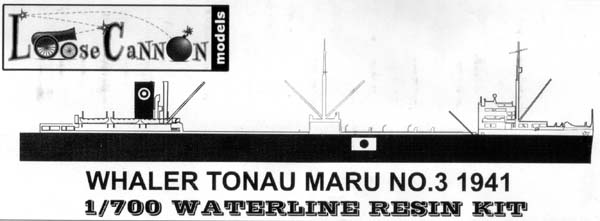
Reviewed by Timothy Dike

| The Tonan Maru #3 was laid down May 27,
1937 in Osaka, Japan as a 19,209 ton whale oil factory ship. She was involved
in whaling seasons in Antarctic waters until December 41 when she was assigned
to the Combined Fleet Supply Force and was used in the invasion of Borneo.
Tonan Maru operated as a troop transport carrying 260 men of the Fourth
Naval Construction Unit for the invasion force. In March 1942 she was converted
to an auxiliary naval tanker. Over the next two years she made many runs
supplying Japanese bases. On her last run she was bound for Truk when she
was intercepted by the USS Tinosa SS-283. The sub fired 15 torpedoes, 13
hit but only 2 detonated. However enough damage is done that Tonan Maru
has to be towed back to Truk. Since heavy repairs could not be made she
is converted to a refueling oil depot.
The US Navy is not done with her and during Operation "Hailstone" - The Attack on Truk in February 1944, she is hit and sunk by US carrier aircraft. After the war in 1951, the ship is refloated and repaired and heads back to Japan for more permanent repairs. Tonan Maru served her final years as a whaling factory ship finally being scrapped in 1970. More information can be found on the Combined Fleets' Tabular Record of Movement page for the Tonan Maru. Loose Cannon has produced yet another obscure ship in resin. This one
represents the Tonan Maru in her early years.
|
|||||||||||||
| HULL PARTS | |||||||||||||
| The hull is a big bulky part cast waterline style with an open stern ramp. Some of the superstructure is cast on with open portholes and some of the deck gear. A little cleanup will be needed on the stern on my sample, but a little filler and some sanding will smooth this out. | Click images
to enlarge |
||||||||||||
|
|||||||||||||
| SUPERSTRUCTURE | |||||||||||||
| Superstructure parts are cast on resin wafers. Some flat sanding will be needed to remove the flash. The bridge is made up of stacked layers which should leave you with an open deck look. Funnels have external piping and solid tops. an assortment of deck winches and gear are included as well. |  |
||||||||||||
|
|||||||||||||
| MASTS AND VENT PIPES | |||||||||||||
| Resin masts and booms are included, but I would suggest using these as templates for the also include brass rod for a stronger assembly. Vent tubes are well cast and will need only some light cleanup. |  |
||||||||||||
|
|||||||||||||
| SHIPS BOATS | |||||||||||||
| Ships boats are cast on resin runners with interior wood planking clearly visible. Light cleanup will be needed along the attachment points. |  |
||||||||||||
|
|||||||||||||
| CARGO | |||||||||||||
| This ship actually did some whaling in 1941 before being pressed into service with the Japanese Navy. So having a cargo of three whales lends realism to the kit. | |||||||||||||
|
|||||||||||||
| PHOTO ETCH | |||||||||||||
| A brass photo etch fret is supplied with railings, ratlines, and ladders. Cable reels, doors and rigging details are among the other parts included. | |||||||||||||
| DECALS | |||||||||||||
| The ship names and markings are nicely printed on the decal sheet. The Lattice bracing is represented by decals that are applied to an acrylic piece. Loose Cannon wants to hear from modelers about how this works for you. So be sure and give them your feedback. | |||||||||||||
| INSTRUCTIONS | |||||||||||||
| The instructions are six pages with history, photos, plan and elevation and a single page with an exploded view of the parts is shown. | |||||||||||||
|
|||||||||||||
| Conclusions: | |||||||||||||

Loose Cannon East has produced a whale of a kit with their latest offering. A kit that can be built as a whaler or a troop transport. Either way a unique one of a kind kit. This is Kit # 1/700 TONAU MARU NO.3 listed for $70.00. Check the Loose Cannon page for details on this and other kits. |
|||||||||||||
